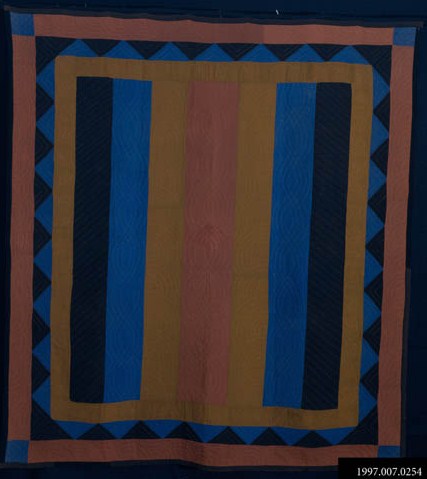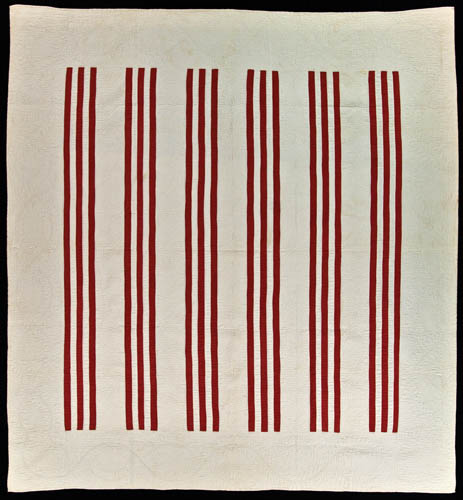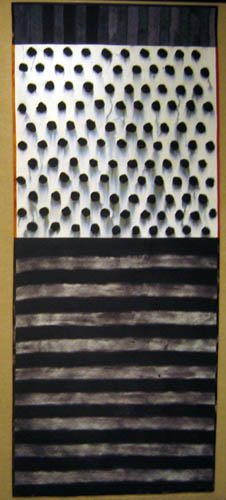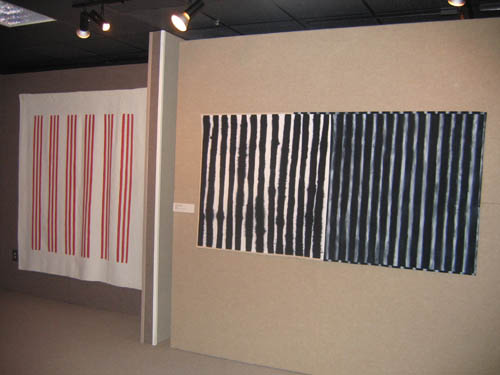
Old Meets New with Fabric, Color, and Paint
by Maureen Ose
This is the first article in a series entitled “Perspectives on Quilts and Quiltmaking” from the International Quilt Study Center & Museum. It takes “the long view” of quilts and quiltmaking expression. Exploring quiltmaking through time and geography connects quiltmakers of the past with today’s creative artists. Each segment will include quilts old and new, investigating how the former inform or inspire the latter.
“If you know whence you came, there are absolutely no limitations to where you can go.”
---James Arthur Baldwin
Bee seeks blossom; bee makes honey. Just so, we discover what nourishes us and fuels our own “production.” The collections of the International Quilt Study Center called to artist Mary Anne Jordan. The work of known and unknown makers from diverse geographies and times fueled her creativity.The result? Freshly conceived studio quilts using fabric, color, and pattern inspired by a previous generation.
Mary Anne Jordan, a professor in the Department of Design at the University of Kansas, was the recipient of the 2005-2006 International Quilt Study Center (IQSC) Visiting Scholar Fellowship. Her work as a contemporary studio quilter shows nationally and internationally in Japan, Poland, South America, and Canada, and draws accolades and awards from such prestigious organizations as Quilt National and Fiber Arts International.


1997_007_0254 Photo courtesy of IQSC 2003_003_0330 Photo courtesy of IQSC
During her study at the IQSC, Mary Anne examined more than 100 quilts to expand her knowledge of American quilts and techniques. She was particularly intrigued by the overlap in the genres of Amish and African American quilts which, in her words, have “uncanny similarities yet are really quite different, as well.” In response to this study, Jordan created a series of bold new designs on fabric. The resulting exhibition, "Snail Trails, Broken Dishes, and a Streak of Lightning," included new work from Jordan, along with selections of the IQSC quilts examined during her research.

Mary Anne with IQSC curator, Marin Hanson. Photo courtesy of IQSC
Beginning with yards and yards of white fabric, Mary Anne dyes, prints, paints, and stitches to reach the final combinations that "magnify everyday life as a metaphor of the structure of our culture, our lives, and our bodies." She draws on a lifetime of encounters with art, primarily in museums. Starting as a child in Toledo, OH, and continuing throughout her education at Cranbrook Academy of Art and the University of Michigan, and as a professor at the University of Kansas, she has remained finely attuned to forms and colors as manipulated by the human hand. Her creations contain many common symbols of daily life.

"Crossing Flag, 2006_052_0002
Crosses have Consider “Crossing Flag”. Crosses have universal meanings: religious significance, assistance and help (the Red Cross, for example), or warnings of traffic intersections. Jordan looked at many cross iterations found in quilts from the IQSC collections of African American and Amish quilts. Then she put her own “human mark” on fabric to express a layered story, perhaps indicating that although caution is advised, the intersection of cultures and individuals is not only inevitable, but also necessary.

"Dot Flag", 2006_052_0001
Another Jordan work that became part of the IQSC collections is “Dot Flag”, currently shown in the museum’s exhibition “Perspectives: Art, Craft, Design, and the Studio Quilt” curated by Michael James and Sandra Sider. The curators shared this observation of that quilt: “Dot Flag is graphic and somber in its grays and blacks, setting color aside to focus on the singular power of light and dark contrasts. Stripes, bars, and dots have always had the ability to arrest attention, and these do.”
Mary Anne’s technique includes application of thickened dyes, controlled spraying and color streaking, and tie-dyeing, sometimes piecing the quilts, other times making a wholecloth quilt. She completes the machine quilting herself, keeping the quilting patterns simple and straightforward, embedding the stitches in subtle circles or grids.

Amish antique quilt hangs near new quilt by Mary Anne Jordan. Photo courtesy of IQSC
Her exhibition combined old and new, paying homage to inspiration and taking the viewer with her to a new interpretation. Mary Ann Jordan is an artist to watch (see more of her work here). She joins the centuries-long tradition of quiltmaking, using our medium to express herself and connect with the world. You can learn more about her techniques and inspiration by viewing a podcast here.
Maureen Ose
Communications Coordinator
International Quilt Study Center & Museum
www.quiltstudy.org

"Crossing Flag", 2006_052_0002
Consider “Crossing Flag”. Crosses have universal meanings: religious significance, assistance and help (the Red Cross, for example), or warnings of traffic intersections. Jordan looked at many cross iterations found in quilts from the IQSC collections of African American and Amish quilts. Then she put her own “human mark” on fabric to express a layered story, perhaps indicating that although caution is advised, the intersection of cultures and individuals is not only inevitable, but also necessary.
"Dot Flag", 2006_052_0001
Another Jordan work that became part of the IQSC collections is “Dot Flag”, currently shown in the museum’s exhibition “Perspectives: Art, Craft, Design, and the Studio Quilt” curated by Michael James and Sandra Sider. The curators shared this observation of that quilt: “Dot Flag is graphic and somber in its grays and blacks, setting color aside to focus on the singular power of light and dark contrasts. Stripes, bars, and dots have always had the ability to arrest attention, and these do.”
Mary Anne’s technique includes application of thickened dyes, controlled spraying and color streaking, and tie-dyeing, sometimes piecing the quilts, other times making a wholecloth quilt. She completes the machine quilting herself, keeping the quilting patterns simple and straightforward, embedding the stitches in subtle circles or grids.

Amish antique quilt hangs near new inspired quilt by Mary Ann Jordan. Photo courtesy of IQSC
Her exhibition combined old and new, paying homage to inspiration and taking the viewer with her to a new interpretation. Mary Ann Jordan is an artist to watch (See more of her work here). She joins the centuries-long tradition of quiltmaking, using our medium to express herself and connect with the world. You can learn more about her techniques and inspiration by viewing a podcast here. (Waiting to hear from IQSC if this podcast is working)

Antique and contemporary quilts hang side by side. Photo courtesy of IQSC
To learn more about the collection and other textiles visit the International Quilt Study Center and Museum here.
Maureen Ose
Communications Coordinator
International Quilt Study Center and Museum
www.quiltstudy.org




.jpg)


